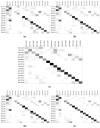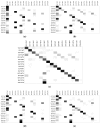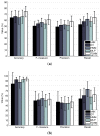Multimodal wireless sensor network-based ambient assisted living in real homes with multiple residents
- PMID: 24887044
- PMCID: PMC4118408
- DOI: 10.3390/s140609692
Multimodal wireless sensor network-based ambient assisted living in real homes with multiple residents
Abstract
Human activity recognition and behavior monitoring in a home setting using wireless sensor networks (WSNs) provide a great potential for ambient assisted living (AAL) applications, ranging from health and wellbeing monitoring to resource consumption monitoring. However, due to the limitations of the sensor devices, challenges in wireless communication and the challenges in processing large amounts of sensor data in order to recognize complex human activities, WSN-based AAL systems are not effectively integrated in the home environment. Additionally, given the variety of sensor types and activities, selecting the most suitable set of sensors in the deployment is an important task. In order to investigate and propose solutions to such challenges, we introduce a WSN-based multimodal AAL system compatible for homes with multiple residents. Particularly, we focus on the details of the system architecture, including the challenges of sensor selection, deployment, networking and data collection and provide guidelines for the design and deployment of an effective AAL system. We also present the details of the field study we conducted, using the systems deployed in two different real home environments with multiple residents. With these systems, we are able to collect ambient sensor data from multiple homes. This data can be used to assess the wellbeing of the residents and identify deviations from everyday routines, which may be indicators of health problems. Finally, in order to elaborate on the possible applications of the proposed AAL system and to exemplify directions for processing the collected data, we provide the results of several human activity inference experiments, along with examples on how such results could be interpreted. We believe that the experiences shared in this work will contribute towards accelerating the acceptance of WSN-based AAL systems in the home setting.
Figures











Similar articles
-
Operating systems for wireless sensor networks: a survey.Sensors (Basel). 2011;11(6):5900-30. doi: 10.3390/s110605900. Epub 2011 May 31. Sensors (Basel). 2011. PMID: 22163934 Free PMC article.
-
Hands-On Experiences in Deploying Cost-Effective Ambient-Assisted Living Systems.Sensors (Basel). 2015 Jun 18;15(6):14487-512. doi: 10.3390/s150614487. Sensors (Basel). 2015. PMID: 26094631 Free PMC article.
-
An open and reconfigurable wireless sensor network for pervasive health monitoring.Methods Inf Med. 2008;47(3):229-34. doi: 10.3414/me9115. Methods Inf Med. 2008. PMID: 18473089
-
Wearable and implantable wireless sensor network solutions for healthcare monitoring.Sensors (Basel). 2011;11(6):5561-95. doi: 10.3390/s110605561. Epub 2011 May 26. Sensors (Basel). 2011. PMID: 22163914 Free PMC article. Review.
-
A comparative study of wireless sensor networks and their routing protocols.Sensors (Basel). 2010;10(12):10506-23. doi: 10.3390/s101210506. Epub 2010 Nov 24. Sensors (Basel). 2010. PMID: 22163483 Free PMC article. Review.
Cited by
-
A Tagless Indoor Localization System Based on Capacitive Sensing Technology.Sensors (Basel). 2016 Sep 7;16(9):1448. doi: 10.3390/s16091448. Sensors (Basel). 2016. PMID: 27618049 Free PMC article.
-
An End-To-End LwM2M-Based Communication Architecture for Multimodal NB-IoT/BLE Devices.Sensors (Basel). 2020 Apr 15;20(8):2239. doi: 10.3390/s20082239. Sensors (Basel). 2020. PMID: 32326598 Free PMC article.
-
Lessons Learned From the Integration of Ambient Assisted Living Technologies in Older Adults' Care: Longitudinal Mixed Methods Study.JMIR Rehabil Assist Technol. 2025 Jun 11;12:e57989. doi: 10.2196/57989. JMIR Rehabil Assist Technol. 2025. PMID: 40369868 Free PMC article.
-
An Interdisciplinary Overview on Ambient Assisted Living Systems for Health Monitoring at Home: Trade-Offs and Challenges.Sensors (Basel). 2025 Jan 30;25(3):853. doi: 10.3390/s25030853. Sensors (Basel). 2025. PMID: 39943492 Free PMC article. Review.
-
Lost in translation? Conceptions of privacy and independence in the technical development of AI-based AAL.Med Health Care Philos. 2023 Mar;26(1):99-110. doi: 10.1007/s11019-022-10126-8. Epub 2022 Nov 8. Med Health Care Philos. 2023. PMID: 36348209 Free PMC article.
References
-
- Gomez C., Paradells J. Wireless Home Automation Networks: A Survey of Architectures and Technologies. IEEE Commun. Mag. 2010;48:92–101.
-
- Martin H., Bernardos A., Bergesio L., Tarrio P. Analysis of Key Aspects to Manage Wireless Sensor Networks in Ambient Assisted Living Environments. Proceedings of the 2nd International Symposium on Applied Sciences in Biomedical and Communication Technologies (ISABEL); Bratislava, Slovakia. 24–27 November 2009; pp. 1–8.
-
- Why Population Aging Matters: A Global Perspective. [(accessed on 28 May 2014)]. Available online: http://www.nia.nih.gov/research/publication/why-population-aging-matters....
-
- Alemdar H., Ersoy C. Wireless Sensor Networks for Healthcare: A Survey. Comput. Netw. 2010;54:2688–2710.
-
- Alemdar H., Ertan H., Incel O.D., Ersoy C. ARAS Human Activity Datasets in Multiple Homes with Multiple Residents. Proceedings of the 7th International Conference on Pervasive Computing Technologies for Healthcare; Venice, Italy. 5–8 May 2013; pp. 232–235.
Publication types
MeSH terms
LinkOut - more resources
Full Text Sources
Other Literature Sources
Medical

